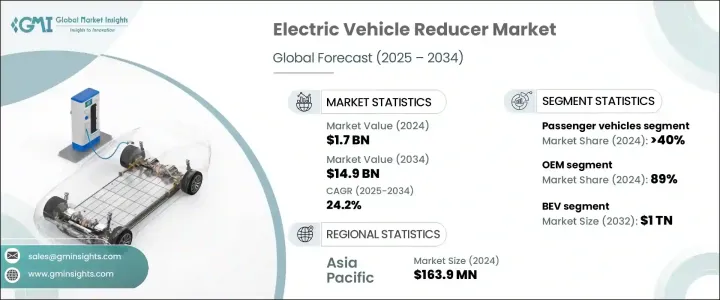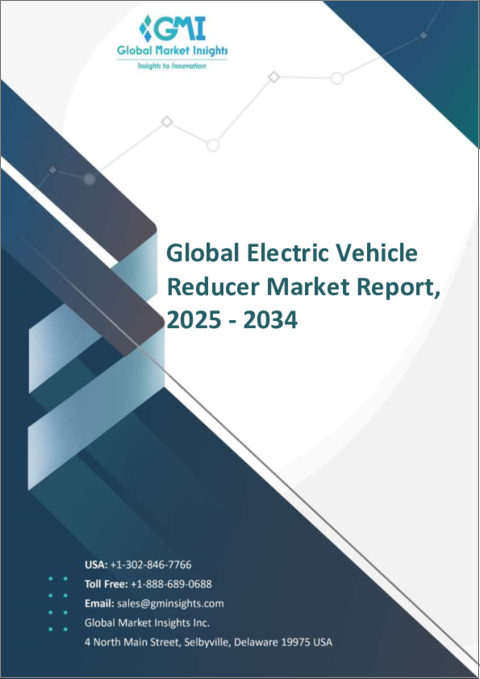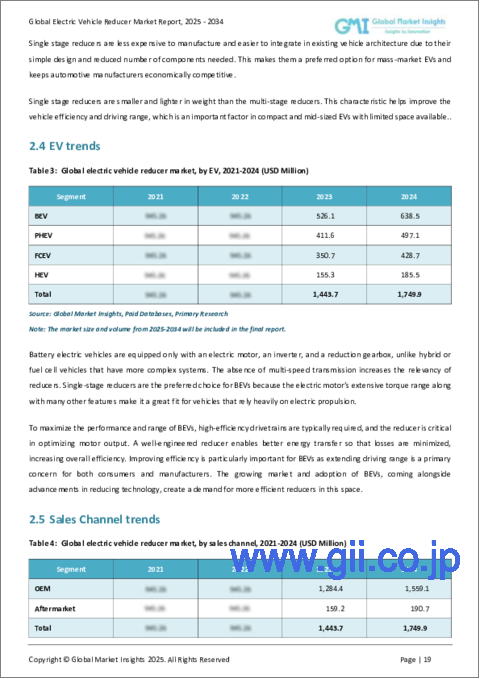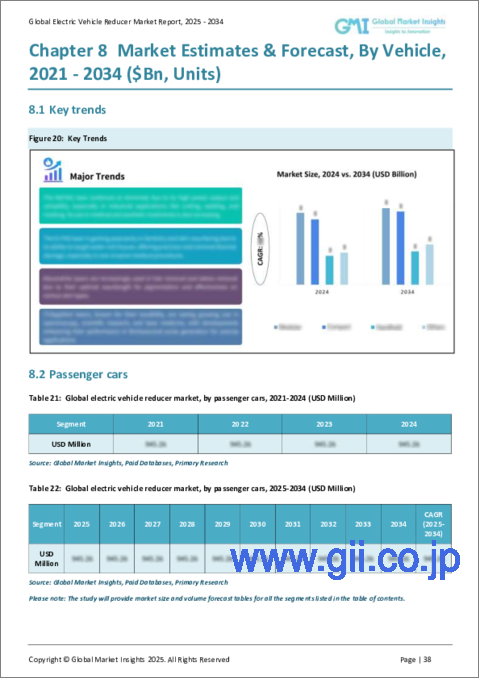|
|
市場調査レポート
商品コード
1740749
電気自動車用減速機の市場機会、成長促進要因、産業動向分析、2025年~2034年予測Electric Vehicle Reducer Market Opportunity, Growth Drivers, Industry Trend Analysis, and Forecast 2025 - 2034 |
||||||
カスタマイズ可能
|
|||||||
| 電気自動車用減速機の市場機会、成長促進要因、産業動向分析、2025年~2034年予測 |
|
出版日: 2025年04月24日
発行: Global Market Insights Inc.
ページ情報: 英文 170 Pages
納期: 2~3営業日
|
全表示
- 概要
- 目次
電気自動車用減速機の世界市場規模は2024年に17億米ドルとなり、CAGR24.2%で成長し、2034年には149億米ドルに達すると予測されています。
この爆発的な成長は、消費者と企業の両方が持続可能な輸送をますます優先するようになり、電動モビリティへの世界の移行が加速していることが原動力となっています。世界各国の政府がより厳しい排ガス規制を導入し、電気自動車導入のための魅力的なインセンティブを提供する中、自動車メーカーはこの需要増に対応するため、電気自動車のラインアップを急速に拡大しています。このシフトは、従来の自動車製造を再構築しているだけでなく、EVコンポーネントのエコシステム全体に前例のない機会を生み出しています。

その中でも、EV用減速機の需要が急増しています。この重要な部品は、高速モーター出力を車輪の扱いやすいトルクに変換することで、ドライブトレインの性能を最適化する上で重要な役割を果たすからです。小型乗用車から大型商用車に至るまで、電気自動車の生産規模が拡大するにつれ、信頼性の高い高効率な減速機の必要性はこれまで以上に重要になっています。相手先商標製品メーカーとTier-1サプライヤーは現在、進化するEVアーキテクチャと期待性能に沿った次世代減速機ソリューションを提供するよう、強いプレッシャーにさらされています。このような機運の高まりにより、減速機市場は、より広範な電動化の展望における重要なイネーブラーとして位置づけられています。
| 市場範囲 | |
|---|---|
| 開始年 | 2024 |
| 予測年 | 2025-2034 |
| 開始金額 | 17億米ドル |
| 予測金額 | 149億米ドル |
| CAGR | 24.2% |
電気自動車に対する世界の需要の高まりは、電気モーターの高速回転を車輪の駆動に使用可能なトルクに変換するのに不可欠なEV用減速機のニーズを直接後押ししています。普及率が高まるにつれて、電気乗用車、商用車、フリートシステムの生産が大幅に増加しており、減速機の消費量が増加しています。メーカーは、性能、耐久性、エネルギー効率のために減速機を最適化することで、この需要に対応しています。特に商用車やロジスティクス用途では、エネルギー損失を最小限に抑えながら連続運転に対応できることから、高度な多段式減速機の需要が高まっています。フリートオペレーターは、総所有コストを削減し、ドライブトレインの信頼性を高める高トルク、低メンテナンスのソリューションをますます求めており、効率的な減速機システムの重要性をさらに強調しています。
電気自動車は、ラストワンマイルの配送、ライドヘイリングサービス、公共交通機関に大きく進出しており、EV減速機市場の範囲を拡大しています。サプライヤーは、ライトデューティとヘビーデューティの両方のEVプラットフォームにシームレスに統合できる、コンパクトで高トルク密度の減速機設計を生み出し、イノベーションを起こす必要に迫られています。性能への期待は高まっており、さまざまな車両クラスの要求を満たすスケーラブルなモジュール式ソリューションへのニーズも高まっています。その結果、大手サプライヤーは、減速機システムのエネルギー効率向上と機械損失低減のための研究開発に多額の投資を行い、EVバリューチェーンにおける役割を強化しています。
車種別では、市場は乗用車、商用車、オフハイウェイ車、二輪車・三輪車に区分されます。2024年には、乗用車が7億米ドルの収益で市場をリードし、40%の市場シェアを獲得します。この優位性は、電気自動車の販売が急拡大していることが主因であり、特に都市部ではクリーンエネルギー自動車が排出ガスの削減、燃料の節約、メンテナンスコストの低減という点で大きなメリットをもたらしています。自動車メーカーは、走行性能と効率を高めるために、専用のEVプラットフォームに減速機を組み込んでいます。
EV用減速機市場は、OEM(相手先ブランド製造)やアフターマーケットなど、販売チャネルによっても分類されます。2024年にはOEMが圧倒的なシェアを占め、売上高全体の89%を占める。減速機は通常、車両組み立て時に取り付けられるドライブトレインの中核部品であるため、OEMは市場拡大において極めて重要な役割を果たしています。テスラ、BYD、フォルクスワーゲンなどの世界のEVメーカーは、厳しい性能ベンチマークを満たすカスタム設計の減速機への需要を促進しており、全地域でOEM主導の成長を後押ししています。
中国の電気自動車用減速機市場は、2024年に1億6,390万米ドルの貢献となり、同国のEV生産におけるリーダーシップを反映しています。中国は、垂直統合されたサプライチェーン、大規模な生産能力、競争力のある価格設定により、減速機を含むEV部品製造の世界のハブとなっています。大量注文に迅速かつコスト効率よく対応できることから、中国は世界市場で圧倒的な地位を占めています。
EV用減速機の世界市場における主要企業には、 ZF Friedrichshafen, BorgWarner Inc., Robert Bosch, Schaeffler AG, GKN Automotive, Magna International, and Nidec Corporationなどがあります。これらの企業は技術革新に力を入れており、性能、寿命、統合の柔軟性を改善した次世代減速機を開発しています。自動車メーカーとの戦略的提携により、特定のEVプラットフォーム向けに減速機システムをカスタマイズすることが可能になり、市場での地位をさらに強固なものにしています。
目次
第1章 調査手法と範囲
第2章 エグゼクティブサマリー
第3章 業界考察
- エコシステム分析
- サプライヤーの情勢
- 原材料サプライヤー
- 部品メーカー
- システムインテグレーターおよびテクノロジープロバイダー
- エンドユーザー
- 利益率分析
- トランプ政権による関税への影響
- 貿易への影響
- 貿易量の混乱
- 報復措置
- 業界への影響
- 供給側の影響(原材料)
- 主要原材料の価格変動
- サプライチェーンの再構築
- 生産コストへの影響
- 需要側の影響(販売価格)
- 最終市場への価格伝達
- 市場シェアの動向
- 消費者の反応パターン
- 供給側の影響(原材料)
- 影響を受ける主要企業
- 戦略的な業界対応
- サプライチェーンの再構成
- 価格設定と製品戦略
- 政策関与
- 展望と今後の検討事項
- 貿易への影響
- テクノロジーとイノベーションの情勢
- 特許分析
- 価格分析
- 地域別
- EV別
- 主なニュースと取り組み
- 規制情勢
- 影響要因
- 促進要因
- 電気自動車販売の急速な成長
- 商用車およびフリート車両の電動化
- EVドライブトレイン技術の進歩
- 政府の規制とインセンティブ
- 業界の潜在的リスク&課題
- 材料供給の制約
- EVドライブトレイン部品の初期コストが高め
- 促進要因
- 成長可能性分析
- ポーター分析
- PESTEL分析
第4章 競合情勢
- イントロダクション
- 企業の市場シェア分析
- 競合ポジショニングマトリックス
- 戦略的展望マトリックス
第5章 市場推計・予測:タイプ別、2021-2034
- 主要動向
- 単段減速機
- 多段減速機
第6章 市場推計・予測:EVで、2021-2034
- 主要動向
- 電気自動車
- PHEV
- 燃料電池自動車
- ハイブリッド車
第7章 市場推計・予測:販売チャネル別、2021-2034
- 主要動向
- OEM
- アフターマーケット
第8章 市場推計・予測:車両別、2021-2034
- 主要動向
- 乗用車
- セダン
- SUV
- ハッチバック
- 商用車
- 小型商用車
- MCV
- HCV
- オフロード車
- 二輪車と三輪車
第9章 市場推計・予測:地域別、2021-2034
- 主要動向
- 北米
- 米国
- カナダ
- 欧州
- 英国
- ドイツ
- フランス
- イタリア
- スペイン
- ロシア
- 北欧諸国
- アジア太平洋地域
- 中国
- インド
- 日本
- オーストラリア
- 韓国
- 東南アジア
- ラテンアメリカ
- ブラジル
- メキシコ
- アルゼンチン
- 中東・アフリカ
- アラブ首長国連邦
- 南アフリカ
- サウジアラビア
第10章 企業プロファイル
- Aichi Machine Industry
- BorgWarner
- GKN Automotive
- Hyundai Transys
- Jatco
- JTEKT
- Magna International
- Nidec Corporation
- Punch Powertrain
- Ricardo plc
- Robert Bosch
- RSB Global
- Schaeffler
- TATA Autocamp
- Valeo
- Vitesco Technologies
- ZF Friedrichshafen
- Zhejiang Wanliyang
The Global Electric Vehicle Reducer Market was valued at USD 1.7 billion in 2024 and is estimated to grow at a CAGR of 24.2% to reach USD 14.9 billion by 2034. This explosive growth is driven by the accelerating global transition toward electric mobility, as both consumers and corporations increasingly prioritize sustainable transportation. As governments across the globe roll out stricter emission regulations and offer attractive incentives for EV adoption, automakers are rapidly expanding their electric vehicle lineups to meet this rising demand. The shift is not only reshaping traditional vehicle manufacturing but also creating unprecedented opportunities across the EV component ecosystem.

Among these, the demand for EV reducers has surged, as these critical components play a vital role in optimizing drivetrain performance by converting high-speed motor output into manageable torque for the wheels. As electric vehicle production scales up-from compact passenger cars to heavy-duty commercial fleets-the need for reliable, high-efficiency reducers is becoming more crucial than ever. Original equipment manufacturers and tier-1 suppliers are now under intense pressure to deliver next-generation reducer solutions that align with evolving EV architectures and performance expectations. This rising momentum positions the reducer market as a key enabler in the broader electrification landscape.
| Market Scope | |
|---|---|
| Start Year | 2024 |
| Forecast Year | 2025-2034 |
| Start Value | $1.7 Billion |
| Forecast Value | $14.9 Billion |
| CAGR | 24.2% |
The rising global demand for electric vehicles has directly boosted the need for EV reducers, which are essential in converting the high rotational speed of electric motors to usable torque for driving wheels. As adoption rates grow, the production of electric passenger cars, commercial vehicles, and fleet systems is increasing significantly, leading to higher consumption of reducers. Manufacturers are responding to this demand by optimizing reducers for performance, durability, and energy efficiency. Particularly in commercial and logistics applications, advanced multi-stage reducers are in high demand due to their ability to handle continuous operations while minimizing energy losses. Fleet operators are increasingly seeking high-torque, low-maintenance solutions that reduce the total cost of ownership and enhance drivetrain reliability, which further underscores the importance of efficient reducer systems.
Electric vehicles are making substantial inroads in last-mile delivery, ride-hailing services, and public transportation, expanding the scope of the EV reducer market. Suppliers are under growing pressure to innovate, producing compact, high-torque-density reducer designs that seamlessly integrate into both light-duty and heavy-duty EV platforms. The performance expectations are rising, and so is the need for scalable, modular solutions that meet the demands of various vehicle classes. As a result, major suppliers are heavily investing in R&D to improve energy efficiency and reduce mechanical losses in reducer systems, reinforcing their role in the EV value chain.
In terms of vehicle type, the market is segmented into passenger cars, commercial vehicles, off-highway vehicles, and two- and three-wheelers. In 2024, passenger vehicles led the market with USD 700 million in revenue, capturing a 40% market share. This dominance is largely due to the rapid expansion of electric car sales, especially in urban areas where clean energy vehicles offer substantial benefits in terms of emissions reduction, fuel savings, and lower maintenance costs. Automakers are embedding reducers into purpose-built EV platforms to enhance driving performance and efficiency.
The EV reducer market is also categorized by sales channels, including original equipment manufacturers (OEMs) and the aftermarket. OEMs dominated in 2024, accounting for 89% of total sales. Because reducers are core drivetrain components typically installed during vehicle assembly, OEMs play a pivotal role in market expansion. Global EV manufacturers such as Tesla, BYD, and Volkswagen are driving demand for custom-engineered reducers that meet strict performance benchmarks, fueling OEM-led growth across all regions.
The China Electric Vehicle Reducer Market contributed USD 163.9 million in 2024, reflecting the country's leadership in EV production. China's vertically integrated supply chain, massive production capabilities, and competitive pricing make it a global hub for EV component manufacturing, including reducers. The ability to fulfill high-volume orders quickly and cost-effectively positions China as a dominant player in the global market.
Key players in the global EV reducer market include ZF Friedrichshafen, BorgWarner Inc., Robert Bosch, Schaeffler AG, GKN Automotive, Magna International, and Nidec Corporation. These companies are heavily focused on technological innovation, developing next-generation reducers that deliver improved performance, longevity, and integration flexibility. Strategic collaborations with automakers allow them to tailor reducer systems for specific EV platforms, further solidifying their market position.
Table of Contents
Chapter 1 Methodology & Scope
- 1.1 Research design
- 1.1.1 Research approach
- 1.1.2 Data collection methods
- 1.2 Base estimates & calculations
- 1.2.1 Base year calculation
- 1.2.2 Key trends for market estimation
- 1.3 Forecast model
- 1.4 Primary research and validation
- 1.4.1 Primary sources
- 1.4.2 Data mining sources
- 1.5 Market scope & definition
Chapter 2 Executive Summary
- 2.1 Industry 3600 synopsis, 2021 - 2034
Chapter 3 Industry Insights
- 3.1 Industry ecosystem analysis
- 3.2 Supplier landscape
- 3.2.1 Raw material suppliers
- 3.2.2 Component manufacturers
- 3.2.3 System integrators and technology providers
- 3.2.4 End-users
- 3.3 Profit margin analysis
- 3.4 Impact of Trump administration tariffs
- 3.4.1 Impact on trade
- 3.4.1.1 Trade volume disruptions
- 3.4.1.2 Retaliatory measures
- 3.4.2 Impact on industry
- 3.4.2.1 Supply-side impact (raw materials)
- 3.4.2.1.1 Price volatility in key materials
- 3.4.2.1.2 Supply chain restructuring
- 3.4.2.1.3 Production cost implications
- 3.4.2.2 Demand-side impact (selling price)
- 3.4.2.2.1 Price transmission to end markets
- 3.4.2.2.2 Market share dynamics
- 3.4.2.2.3 Consumer response patterns
- 3.4.2.1 Supply-side impact (raw materials)
- 3.4.3 Key companies impacted
- 3.4.4 Strategic industry responses
- 3.4.4.1 Supply chain reconfiguration
- 3.4.4.2 Pricing and product strategies
- 3.4.4.3 Policy engagement
- 3.4.5 Outlook & future considerations
- 3.4.1 Impact on trade
- 3.5 Technology & innovation landscape
- 3.6 Patent analysis
- 3.7 Price analysis
- 3.7.1 By region
- 3.7.2 By EV
- 3.8 Key news & initiatives
- 3.9 Regulatory landscape
- 3.10 Impact forces
- 3.10.1 Growth drivers
- 3.10.1.1 Rapid growth in electric vehicle sales
- 3.10.1.2 Electrification of commercial and fleet vehicles
- 3.10.1.3 Advancements in EV drivetrain technology
- 3.10.1.4 Government regulations & incentives
- 3.10.2 Industry pitfalls & challenges
- 3.10.2.1 Material supply constraints
- 3.10.2.2 High initial costs of EV drivetrain components
- 3.10.1 Growth drivers
- 3.11 Growth potential analysis
- 3.12 Porter's analysis
- 3.13 PESTEL analysis
Chapter 4 Competitive Landscape, 2024
- 4.1 Introduction
- 4.2 Company market share analysis
- 4.3 Competitive positioning matrix
- 4.4 Strategic outlook matrix
Chapter 5 Market Estimates & Forecast, By Type, 2021 - 2034 ($Bn, Units)
- 5.1 Key trends
- 5.2 Single-stage reducers
- 5.3 Multi-stage reducers
Chapter 6 Market Estimates & Forecast, By EV, 2021 - 2034 ($Bn, Units)
- 6.1 Key trends
- 6.2 BEV
- 6.3 PHEV
- 6.4 FCEV
- 6.5 HEV
Chapter 7 Market Estimates & Forecast, By Sales Channel, 2021 - 2034 ($Bn, Units)
- 7.1 Key trends
- 7.2 OEM
- 7.3 Aftermarket
Chapter 8 Market Estimates & Forecast, By Vehicle, 2021 - 2034 ($Bn, Units)
- 8.1 Key trends
- 8.2 Passenger cars
- 8.2.1 Sedan
- 8.2.2 SUV
- 8.2.3 Hatchback
- 8.3 Commercial vehicle
- 8.3.1 LCV
- 8.3.2 MCV
- 8.3.3 HCV
- 8.4 Off highway vehicle
- 8.5 Two and three wheelers
Chapter 9 Market Estimates & Forecast, By Region, 2021 - 2034 ($Bn, Units)
- 9.1 Key trends
- 9.2 North America
- 9.2.1 U.S.
- 9.2.2 Canada
- 9.3 Europe
- 9.3.1 UK
- 9.3.2 Germany
- 9.3.3 France
- 9.3.4 Italy
- 9.3.5 Spain
- 9.3.6 Russia
- 9.3.7 Nordics
- 9.4 Asia Pacific
- 9.4.1 China
- 9.4.2 India
- 9.4.3 Japan
- 9.4.4 Australia
- 9.4.5 South Korea
- 9.4.6 Southeast Asia
- 9.5 Latin America
- 9.5.1 Brazil
- 9.5.2 Mexico
- 9.5.3 Argentina
- 9.6 MEA
- 9.6.1 UAE
- 9.6.2 South Africa
- 9.6.3 Saudi Arabia
Chapter 10 Company Profiles
- 10.1 Aichi Machine Industry
- 10.2 BorgWarner
- 10.3 GKN Automotive
- 10.4 Hyundai Transys
- 10.5 Jatco
- 10.6 JTEKT
- 10.7 Magna International
- 10.8 Nidec Corporation
- 10.9 Punch Powertrain
- 10.10 Ricardo plc
- 10.11 Robert Bosch
- 10.12 RSB Global
- 10.13 Schaeffler
- 10.14 TATA Autocamp
- 10.15 Valeo
- 10.16 Vitesco Technologies
- 10.17 ZF Friedrichshafen
- 10.18 Zhejiang Wanliyang





